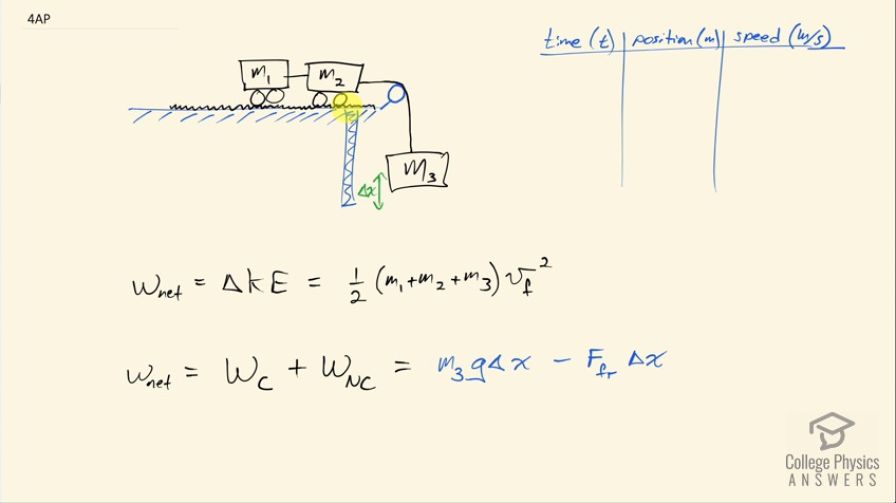Question
You have a cart track, two carts, several masses, a position-sensing pulley, and a piece of carpet (a rough surface) that will fit over the track. Design an experiment to examine how the force exerted on the cart does work as the cart moves through a distance.
Final Answer
Please see the solution video.
Solution video
OpenStax College Physics for AP® Courses, Chapter 7, Problem 4 (Test Prep for AP® Courses)

vote with a rating of
votes with an average rating of
.
Video Transcript
This is College Physics Answers with Shaun Dychko. In this experiment, we have two carts, the cart track, a piece of carpet to put on the cart track and I think the intention for that is to create some friction... or not if we take the carpet away, there's no friction suppose and then we put the carpet there and we introduce some friction. We have a position-sensing pulley which can tell us how far this weight m 3, which is hanging, will move down or how far the carts move to the side and... yeah! So we know what the masses of the carts are, we know what mass this hanging mass m 3 is and it's going to go some distance Δx and we know what this because this is a position-sensing pulley and we can create a data table probably a couple of data tables... one for when there is a carpet and then perhaps another one when there is no carpet into two different experiments; the experiment with the carpet could be to figure out what is the friction force say if we figured out the time and the position and then therefore the speed here with the carpet, we can say that the net work done is change in kinetic energy which is one-half times the total mass of the system times its final velocity assuming that it starts from rest I mean there's also a minus one-half total mass times initial velocity squared but it starts at a speed of zero so this term is zero. So we can take this net work and then compare that with the net work expressed differently as the work done by the conservative forces plus the work done by the non-conservative forces. The conservative force here is the force of gravity, which is m 3 times the gravitational field strength g and then that multiplied by this change in position Δx is the work done by gravity and then we are going to have the force of friction in the opposite direction so it will be negative and it is going to be doing some work over the same distance Δx because these carts on the cart track will move the same distance as this hanging mass will so the same Δx is here so minus the force of friction times Δx is the work done by friction and then this will equal this and then you can solve for the force of friction that would be kind of interesting— and you can say the force of friction would be one-half times m 1 plus m 2 plus m 3 times final speed squared minus m 3gΔx all divided by negative Δx yeah... and then you can figure out the coefficient of friction as well knowing the mass of the carts and you can take the carpet away and so there's no friction and then verify that the net work done based on the change in kinetic energy is equal to the work done by gravity. Okay!